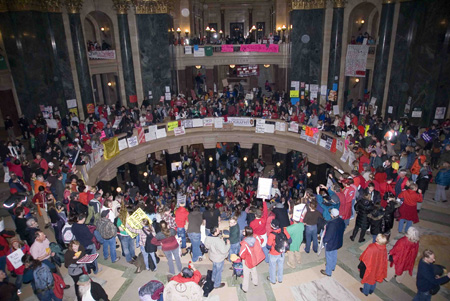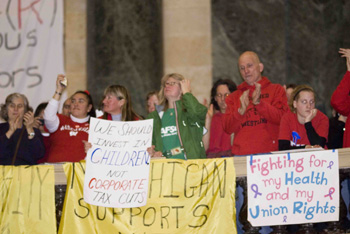Revolution #225, February 27, 2011
Correspondence from the Wave of Protests in Madison
Madison, Wisconsin. On Saturday, February 19, an estimated 80,000 to 100,000 people are in the 5th day of a round-the-clock occupation of the state capitol building. Large and small protest marches demand the defeat of a bill to take away collective bargaining rights for teachers and all public sector employees except firemen or policemen.
 |
| Madison, WI State Capitol Rotunda, Sunday, February 20, 2011 Photo: Larry Redmond |
On Friday, February 11, Wisconsin Governor Scott Walker introduced a bill that would strip collective bargaining rights from some 300,000 public sector employees in the state. The UK Guardian characterized this as the "most sustained union-bashing measures proposed in the US for decades."
On Tuesday, February 15, 13,000 people descended on the Wisconsin State capitol in Madison in protest and every day since then the crowds have grown. Across the state there was an immediate response, a defiant NO! The mass protest spread like wildfire. High school students staged walk outs in support of their teachers; 10% of the teachers in Milwaukee and Green Bay called in sick on Thursday. Schools closed for three days last week in Madison and on Friday in Milwaukee. Hundreds of University of Wisconsin students marched up State Street to the capitol, and thousands came from UW campuses around the state. People from small towns and cities, as well as Milwaukee, poured into Madison to protest this attack.
 |
| Madison, WI State Capitol Rotunda, Sunday, February 20, 2011 Photo: Larry Redmond |
The bill was scheduled to be passed on Thursday, February 17, by the Republican majority, but with thousands of protestors occupying the capitol and resolutely demanding "Kill the Bill", the 14 Democratic state senators left Wisconsin. This meant that the Senate could not constitute the quorum needed to take a vote. As of today (Tuesday), they are still in Illinois and the bill has been prevented from passing.
Coming into town you begin to see people with protest signs standing along the side of the road a mile before you get to the capitol building, the epicenter of the protest. On the way into town we went past West High School where a couple hundred people were gathered—with more coming in—and this protest was a small foretaste of the thousands and thousands at the capitol itself.
Inside the capitol building itself are thousands more, while huge crowds circulate around the building outside. There is a joyous feel to all this, a certain festival atmosphere of taking things into their own hands. Under the dome of the Wisconsin state capitol building, people are stacked wall to wall and shoulder to shoulder, three stories high; they have occupied the building 24 hours a day since Tuesday the 15th. The chanting is so loud that people congregate in little groups on the staircases to talk. The two main chants are "This is what democracy looks like" and "Kill the Bill." Banners of support from around the country vie for space with banners listing demands, including the principal demand to "Kill the Bill," as well as other demands such as "recall Scott Walker." At the official information center on the second floor there is a poster where people can list the schools that have been closed by teachers "sick outs."
Teachers, health care workers, social workers told us: "This is not about the money. They are trying to take away our ability to advocate for the peoples' needs. This will be a disaster for the kids, they want to privatize the schools. They want to silence our voice so they can destroy public education, public health care and social services. We are advocates for the students, for the poor. We care deeply about the children and the future of public education. If they can silence our voice, then it's their world."
One high school student expressed the sentiments of many: "I love my teacher, I came out to support the teachers. This will crush the teachers union. It will be more difficult to get the resources the schools need. It will destroy the schools. If we can get enough people out here, we can turn this around."
Political analysts from the Christian Science Monitor to the New York Times have posed that in a "time when large and tense demonstrations have been increasingly rare in America" this outpouring could spark an "Egypt like moment." (CSM) Salted through the crowds were references to the uprisings in Egypt and the Middle East: on an entrance to the Rotunda inside the capital building "Welcome to Wis-Cairo," "Mubarak, Walker—one down one to go." "Walk like an Egyptian." A couple women in their late twenties, who made a point that they worked for a union in the private sector but were there because this struggle was so important, commented that "Egypt caught the wave from Tunisia, we caught the wave from Egypt and now we are passing it on. We are all surfers now." We laughed together as we considered the image of surfing in the cold Wisconsin air.
People proudly identified themselves as NOT directly affected by the attack this bill represented—but were there in support of the rights of teachers and other public sector workers. Taking a stand at this crucial time in this crucial place. They carried signs like "I'm not part of a union but I still support those who are." Firefighters, who were exempted (along with police) from the attack, joined the protest in groups. Doctors in their white coats came to write excused absences for teachers who called in sick. A number of Green Bay Packers publicly supported the protesters, most prominently Charles Woodson, NFL defensive player of the year. Religious leaders in Illinois publicly offered their homes and churches as sanctuary for the 14 Democratic state senators.
One woman came up to us and said, "It's about time we stopped being nice!" It took a minute but we realized she was talking about this protest marking an end to "finding common ground" with right-wing fascists.
And references to the danger of fascism, permanent Republican Control, right-wing domination of the political agenda…these sprang up here and there as people reflected on what passage of this bill would mean broadly in society. Or commented on the fact that Walker was only one of a number of Republican governors pushing this agenda. A few people referenced Hitler's 1933 decree outlawing trade unions in the Third Reich.
The new statement "On the Strategy for Revolution" describes "sudden jolts and breakdowns in the 'normal functioning' of society, which compel many people to question and to resist what they usually accept." This is definitely one of those jolts where people have poured into the streets in resistance against a reactionary attempt to crush the union as part of an overall strategy of dismantling public education and public social services. At this point the people identify the problem as the Republican Governor Walker. But the statement makes a very important point that these are the kind of situations "in which many more people are searching for answers and open to considering radical change," and that through such situations, leaps can be made in building up the movement and the organized forces for revolution, creating in this way a stronger basis from which to work for further advances.
With this in mind we took out "The Revolution We Need, and the Leadership We Have" (the Message and Call) very broadly. It was crazy loud inside and outside the capitol and difficult to get into discussions but we were able to talk briefly. People were generally not thinking that revolution is what's needed, but most were very open to it, wanting to know "what kind of revolution are you talking about?" The palm card for Bob Avakian's Revolution Talk went like hotcakes because it said "Revolution" on it. The palm card for the Constitution For The New Socialist Republic In North America (Draft Proposal) raised more serious questions about communism and what kind of society are you talking about? In getting out Bob Avakian's statement on Egypt: "Egypt 2011: Millions Have Heroically Stood Up…The Future Remains to be Written" and Revolution with Egypt on the cover, many people did not know much about what happened in Egypt. University students were more aware and commented on getting inspiration from it.
If you like this article, subscribe, donate to and sustain Revolution newspaper.



